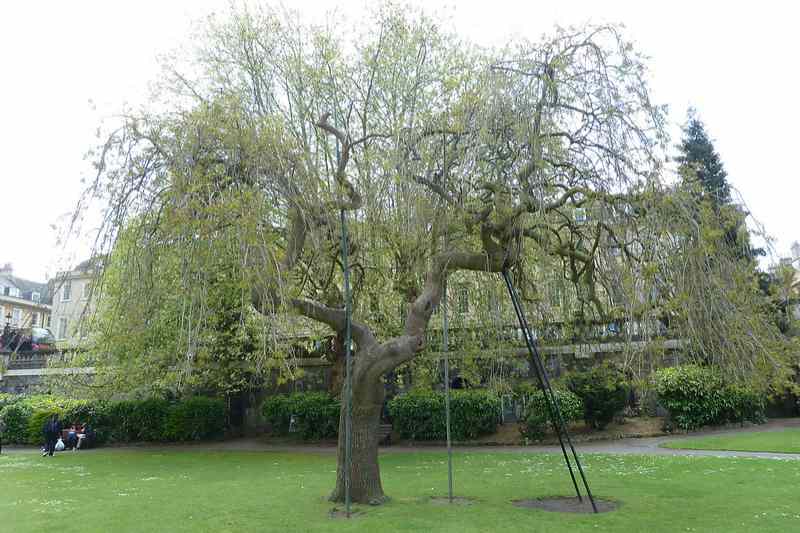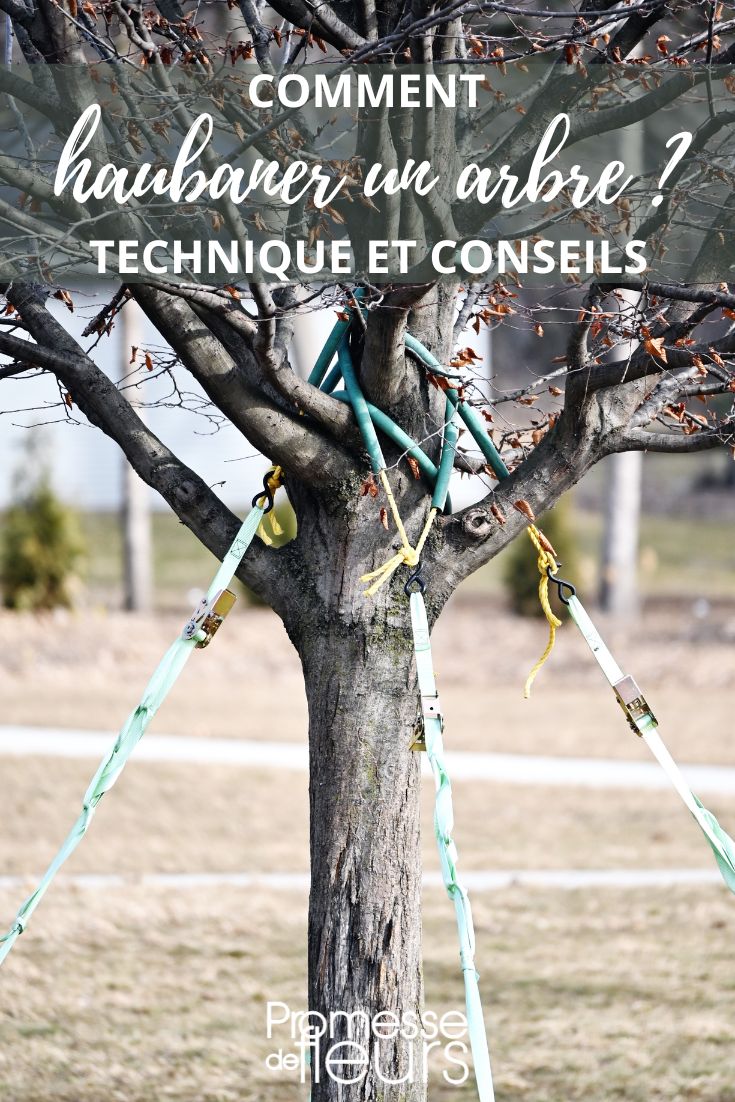Guying is a technique reserved for trees you want to protect from strong winds or to straighten in a garden, anchoring them to soil with support cables.
If usually carried out by professionals for very large trees in urban settings, here is how to do a 3-point guying, a technique that distributes trunk tensions and weight well on a garden tree not exceeding 15 metres in height.

What is guying?
Guying a tree involves surrounding and supporting its main branches, its branches or its trunk with a kind of super-stake: rigid cables called guys. While staking is done at planting, guying is usually performed when tree is large, a few years old and shows a defect: it leans, suffers from violent winds, its branches are cracked, it has been weakened by a fungus or during transplanting.
This technique is therefore often used by municipal Parks and Gardens teams to secure trees weakened by age or disease, holding them firmly against climatic hazards, or to <strong straighten younger trees that lean too much, risking branch breakage. Some notable trees in distress or that have been uprooted can thus be saved with appropriate guying.

The technique
Guying technique provides better support to trees than staking and is more effective in gardens exposed to strong winds. But it is more complex to implement and requires follow-up to adjust cables over time. Several guys are therefore placed to stabilise main branches.
There are several types of guying: single-point guying (one anchor point) to stabilise small trees or specific branches requiring minimal support; V or cross guying (two anchor points forming a V, or two opposite anchor points), used for larger trees or structures needing more robust, balanced stabilisation, notably to correct significant lean or imbalance.
This tutorial covers three-point guying, recommended to stabilise large trees or structures needing maximal, balanced support, particularly to correct significant inclinations.
N.B.: always recommend calling in arborists or tree experts for guying of very old specimens or trees presenting a safety issue.
When to guy a tree?
Work preferably in spring or autumn to avoid stressing tree unnecessarily, at start or end of day to avoid high temperatures and on a calm day.
Equipment
Commercially available guying kits exist according to tree height and development. They consist of:
- stakes or anchors to drive into soil
- guy cables or steel cables
- 3 hook tensioners (for 3-point guying)
- protection for bark: flexible material sheath to wrap trunk or guyed branch (rubber collar, inner tube, hessian)
- 3 clamps and 9 wire rope clips with saddle
- 3 stakes in acacia or chestnut
- galvanised steel cable or prop
Also prepare for this job:
- step ladder or ladder
- sledgehammer or mallet
- saw
- optional concrete blocks to ensure stability for very large subjects
Analyse tree structure beforehand to identify weak points and zones needing support. Three anchor points should be well distributed around tree.
1/ Place three stakes around tree at equal distance. Wrap each stake end with a steel wire and twist using pincers (this avoids splitting wood when striking);
2/ Drive stakes in with sledgehammer to two-thirds of their height, angled at 55° outwards;
3/ Drive in a clamp a few millimetres at base of first stake with a mallet;
4/ Thread a piece of cable through clamp, make two turns and secure with a wire rope clip;
5/ Attach tensioner taking care to slacken it fully;
6/ Drive clamp in with hammer to lock cable and prevent vertical movement;
7/ Take a galvanised steel cable cut to correct length and fit a wire rope clip with saddle on each end;
8/ End attached to tree must be sleeved in a rubber sheath to protect trunk
9/ Tighten formed loops using wire rope clip with saddle;
10/ Repeat steps 3 to 9 for two other cables and attach sleeved ends to trunk at mid-height;
11/ Attach other ends and adjust cable tension by tightening tensioner. It must be taut, without excess;
12/ Saw off anchor stakes at ground level if too tall;
13/ Visually check that cables are aligned and tree is stable by applying light pressure to tree.
When can guying be removed?
Normally, after three years, tree will have partially rebuilt its root system and can be freed from guying.
Guying must remain in place for life for notable trees or trees that were in distress or that present a safety issue in public areas.
Cables require regular follow-up: they must be adjusted each year in early autumn during tree growth. Readjust cable tension, especially after growth periods or extreme weather. Remember to record intervention details and inspection dates for future follow-up.
Here is our step-by-step visual tutorial to better visualise this technique.
































Comments